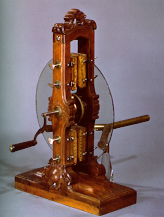
58.3 x 24.5 x 63
Cristal, steel, brass, carved wood,
leather and horn
INDEX 1788 : Q.IV.532
Machina Electrica ex Recentissimo Anglorum (nifalCor) invento, in qua planum Crystallinum orbiculare locum tenet Cylindri vel globi vitrei. Planum hoc movetur inter quatuor pulvillos a duabus parastatis ligneis sustentatos, qui ejusdem plani circunferentiae respondent. Peculiarem habet conductorem ex Orichalco, qui insistit pyramidi Crystallinae.
Electric machine from a very recent English invention (if I am not mistaken) in which an orbicular crystal plane replaces a cylinder or glass sphere. This plane is moved between four pads held in place by two wooden columns which correspond to the circumference of the plane. It has a peculiar brass conductor on a crystal pyramid.
This is one of the first glass disc electrostatic machines. The disc is fixed at the centre to two small brass discs held together by screws. There is a handle at one end of the horizontal axis which rotates the glass disc. As it turns, the disc rubs against four leather pads fixed to two vertical wooden columns; the rotating axis also passes through these columns. The pads are diametrically opposed from one side to the other of the glass disc. The pressure of each pad on the glass is adjusted by two screws on the outer part.
This machine has a Y-shaped brass conductor made from three cylindrical branches, arranged horizontally. The conductor rests on a glass support which acts as an insulator. Two ends of the Y have three sharp points, each of which is to be electrically charged by induction by the friction of the disc rotating against the pads. The points are placed a few millimetres from the glass. In these conditions, once the disc is activated, the tubes nearest to it receive an opposite charge to that of the disc, and the third tube receives the same charge as the disc.
From Colégio dos Nobres, catalogue n.º 516.Sigaud de la Fond, Joseph-Aignan, Description et Usage d'un Cabinet de Physique Expérimentale, Paris, 1775, Vol. II, Pl. XX.